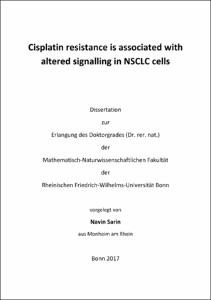Cisplatin resistance is associated with altered signalling in NSCLC cells

Cisplatin resistance is associated with altered signalling in NSCLC cells

| dc.contributor.advisor | Jaehde, Ulrich | |
| dc.contributor.author | Sarin, Navin | |
| dc.date.accessioned | 2020-04-24T22:08:56Z | |
| dc.date.available | 2020-04-24T22:08:56Z | |
| dc.date.issued | 18.01.2018 | |
| dc.identifier.uri | https://hdl.handle.net/20.500.11811/7474 | |
| dc.description.abstract | The efficacy of cisplatin-based chemotherapy in cancer is limited by the occurrence of innate and acquired drug resistance. In order to better understand the mechanisms underlying acquired cisplatin resistance, the adenocarcinoma-derived non-small cell lung cancer (NSCLC) cell line A549 and its cisplatin-resistant sub-line A549rCDDP2000 were compared with regard to cellular platinum accumulation, DNA-adduct formation, cell cycle alterations, apoptosis induction and activation of key players of DNA-damage response. In A549rCDDP2000 cells, the cisplatin-induced G2/M cell cycle arrest was lacking and apoptosis was significantly reduced compared to A549 cells, although equitoxic cisplatin concentrations resulted in comparable platinum-DNA adduct levels. These differences were accompanied by changes in the expression of proteins involved in DNA-damage response. In A549 cells, cisplatin exposure led to a significantly higher expression of genes coding for proteins mediating G2/M arrest and apoptosis (MDM2, XPC, SIP and GADD45a) as compared to resistant cells. This was underlined by significantly higher protein levels of pATM and p53 in A549 cells after cisplatin treatment compared to the respective untreated controls. Additionally, a data-driven method was used to identify further key candidates responsible for the different response of the two cell lines to the drug. The cellular transcriptome was screened for relevant gene candidates using a whole genome array. By combining statistical methods with available gene annotation without previously defined hypothesis, HRas, JNK3, p38, CCL2 and DOK1 were identified as genes relevant for cisplatin resistance. These genes were further analysed on transcriptome and proteome level to introduce a more systematic approach on different stages of cell signalling. Here, HRas showed lower protein levels and JNK3 a lower mRNA expression after treatment with cisplatin in A549rCDDP2000 cells. In addition to these short-term effects, SIP, JNK3 and p38 showed higher basal mRNA abundance in resistant control cells compared to the sensitive control cells. This circumstance was also observed with p53 on protein level and suggests a relevant long term effect caused during the development of resistance. All results were compiled in a preliminary model of resistance-associated signalling alterations. In conclusion, these findings suggest that acquired resistance of NSCLC cells against cisplatin is a consequence of altered signalling of the identified proteins leading to reduced G2/M cell cycle arrest and apoptosis. | en |
| dc.language.iso | eng | |
| dc.rights | In Copyright | |
| dc.rights.uri | http://rightsstatements.org/vocab/InC/1.0/ | |
| dc.subject.ddc | 500 Naturwissenschaften | |
| dc.subject.ddc | 610 Medizin, Gesundheit | |
| dc.title | Cisplatin resistance is associated with altered signalling in NSCLC cells | |
| dc.type | Dissertation oder Habilitation | |
| dc.publisher.name | Universitäts- und Landesbibliothek Bonn | |
| dc.publisher.location | Bonn | |
| dc.rights.accessRights | openAccess | |
| dc.identifier.urn | https://nbn-resolving.org/urn:nbn:de:hbz:5n-49176 | |
| ulbbn.pubtype | Erstveröffentlichung | |
| ulbbnediss.affiliation.name | Rheinische Friedrich-Wilhelms-Universität Bonn | |
| ulbbnediss.affiliation.location | Bonn | |
| ulbbnediss.thesis.level | Dissertation | |
| ulbbnediss.dissID | 4917 | |
| ulbbnediss.date.accepted | 21.11.2017 | |
| ulbbnediss.institute | Mathematisch-Naturwissenschaftliche Fakultät : Fachgruppe Pharmazie / Pharmazeutisches Institut/Klinische Pharmazie | |
| ulbbnediss.fakultaet | Mathematisch-Naturwissenschaftliche Fakultät | |
| dc.contributor.coReferee | Bendas, Gerd |
Dateien zu dieser Ressource
Das Dokument erscheint in:
-
E-Dissertationen (4439)




